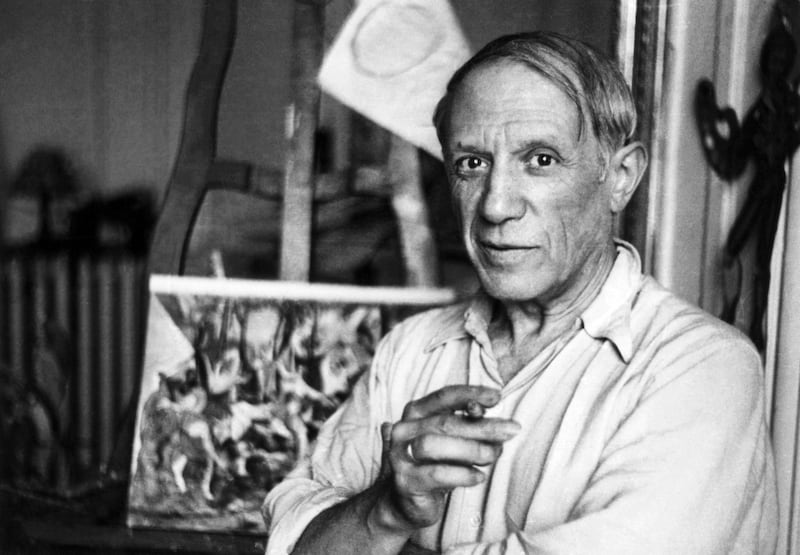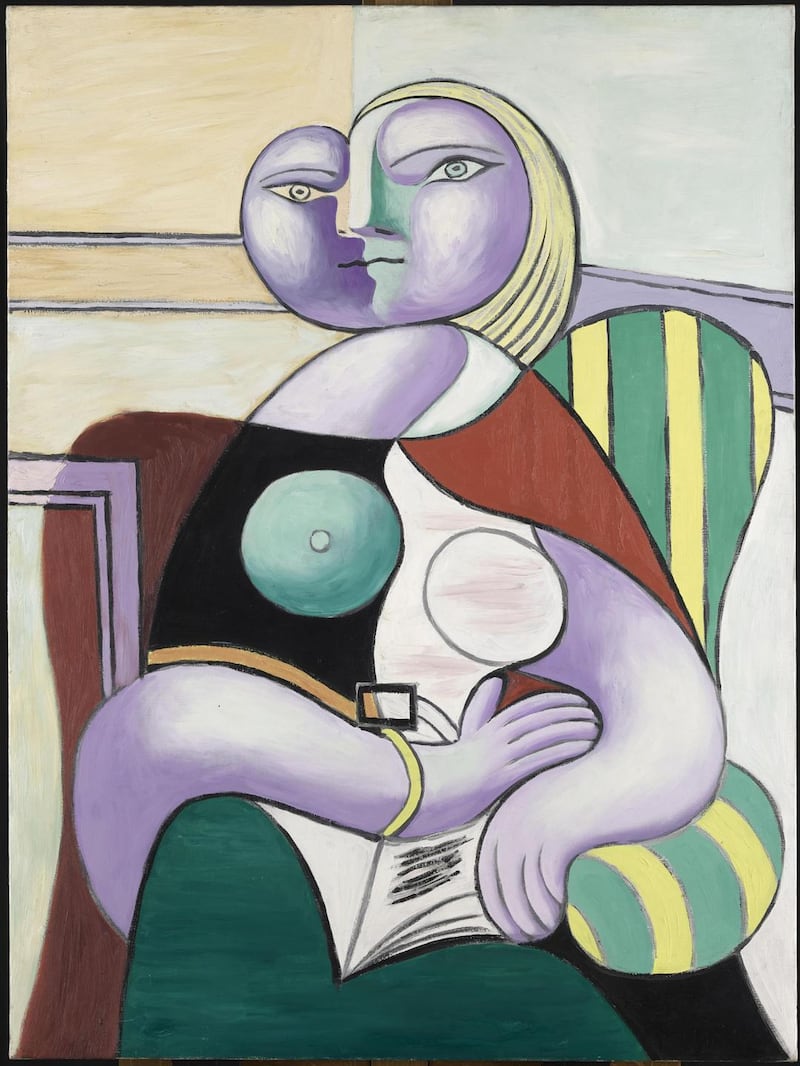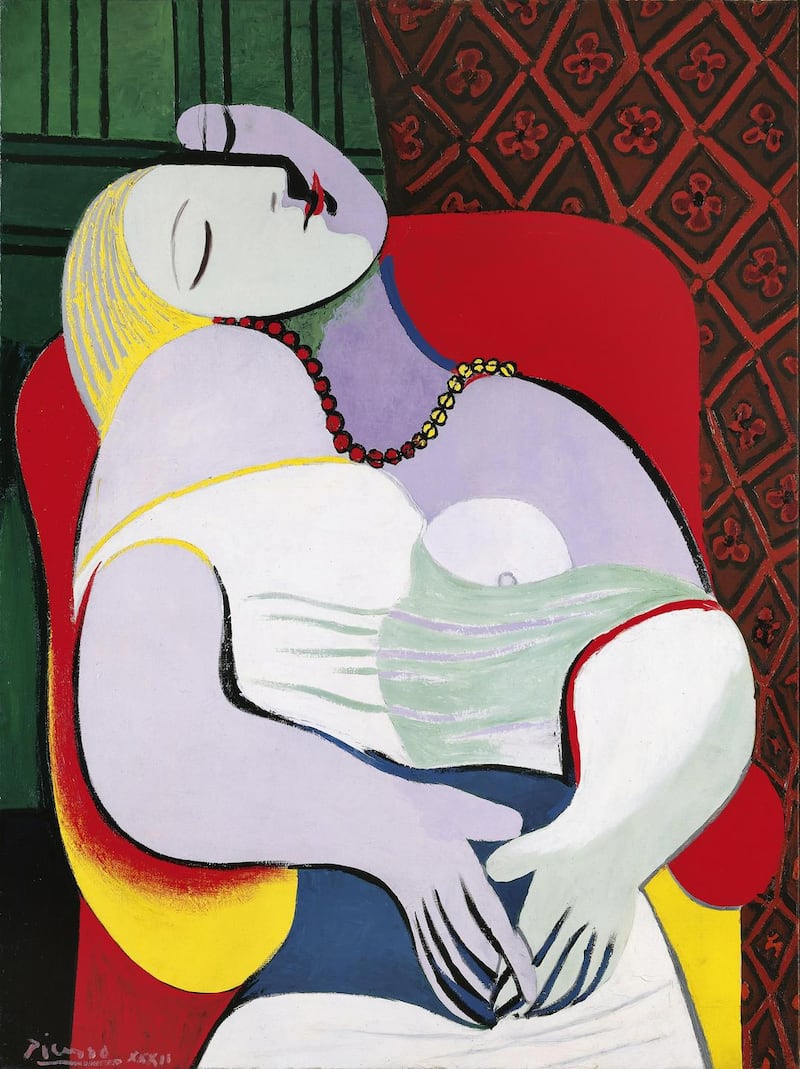By 1932, Pablo Picasso was already the most famous artist in the world. He was 50 years old, lived in a luxurious apartment in central Paris, owned a château in Normandy, and commuted between the two in a chauffeur-driven Hispano-Suiza.
Picasso had a wife, a son and a mistress. The wife, Russian ballet dancer Olga Khokhlova, aged 41, had given up dancing after an ankle injury to devote herself to home-making. Their son Paulo was 11 years old and already taller than his 5ft 3in father. From the outside, the Picassos looked like a happy, bourgeois family. Pablo attended his son's first communion in Paris and worked less during school holidays, to be with Paulo. In September, the three travelled together to Switzerland when the first Picasso retrospective, organised in Paris in June, moved to Zurich.
Yet anyone who observed Picasso's painting that year, including Olga, must have known of his passionate and intensely erotic love affair with 22-year-old Marie-Thérèse Walter. Until 1932, Picasso had refrained from painting Marie-Thérèse in recognisable form. He betrayed their secret on January 2nd, in his first painting of the year, in what is doubtlessly the most beautiful homage to his young mistress, titled Woman Reading.
It was such a pivotal year in Picasso's life that the Musée Picasso in Paris and the Tate Modern in London have joined forces to organise an exhibition which takes visitors through 1932, day by day, in chronological order. Picasso 1932; Erotic Year opens in London's Tate Modern from March 8th until September 9th, where it will be re-named Picasso 1932: Love, Fame, Tragedy.
“Painting is just another way of keeping a diary,” Picasso said on the eve of his 1932 retrospective. He had just selected works from the preceding 30 years, and had the sensation of his life flooding over him.

Picasso dated every painting, and saved every scrap of paper, from dry cleaners’ bills to concert tickets. He subscribed to a newspaper clipping service that kept every mention of him. Because his archives belong to the Musée Picasso, reconstructing 366 days in the life of the artist was relatively easy.
Aside from the paintings and a few photographs, there is no paper trace of Marie-Thérèse, who Picasso saw in the studio that no one else was allowed to enter, and at Boisgeloup, the château whose name means “jealous wood”. He painted frenetically until mid-April, producing dozens of new paintings for the June retrospective.
"Once preparations for the [June 1932] exhibition were over, the sexual tension that is so perceptible in the canvases declines," notes Laurence Madeline, co-commissioner of this year's show.
Sex drive
Picasso's sexual obsession with Marie-Thérèse infused his work with new energy and changed his style. The connection between the artist's creative powers and his sex drive was summed up in a drawing of The Painter Before His Model, dated January 29th, in which the artist's erect penis holds the paint brush.
Picasso’s liaison with Marie-Thérèse began soon after he stopped the then 17-year-old girl outside the Galeries Lafayette department store. “Mademoiselle, you have an interesting face. I would like to paint your portrait,” he told her. Legend has it he added, “I feel we will do great things together.”
It is surprising that in the Harvey Weinstein #MeToo era, no one has attacked Picasso as a sexual predator. In a 1974 interview, one year after Picasso's death and three years before she took her own life, Marie-Thérèse told France Culture radio that Picasso possessed her. "That's the way it is with him. He violates the woman first, then afterwards we work."

Woman Reading, that first portrait of 1932, prefigures many of the paintings that followed. Picasso almost always painted Marie-Thérèse's skin in pale violet tones. He gave her yellow-blonde hair and distinctive, almond-shaped eyes. Her face was usually shown simultaneously from the front and in profile, her breasts as round, fruit-like circles. She was either seated in an armchair or, more often, lying down.
Aside from the breasts and the book in Marie-Thérèse's lap suggesting the shape of a woman's pubis, Woman Reading is comparatively tame. Her heart-shaped face is pleasant, her soft curves invitingly placid.
The Dream, which Picasso painted on January 24th, is more blatant. Marie-Thérèse is again seated in an armchair, but this time she is sleeping, her head leaning on one shoulder. The upper side of her face is in the shape of a penis. The hands in her lap suggest masturbation.

"The osmosis between sexuality and creativity is thus complete, the sexual act and the act of creation becoming interchangeable metaphors," Virginie Perdrisot-Cassan, co-commissioner of the exhibition, writes of The Dream.
In Woman Sitting in a Red Armchair, painted on February 30th, the sitter is not recognisable. A small, round head has vertical buttons in lieu of eyes, and a slit for a mouth. The body parts cloaked in the red of the armchair have been disassembled and rearranged in an empty cavity. Two small, hard spheres could be breasts, or testicles. The club-like forms emerging from the cavity could be arms and hands, legs and feet, or phalluses. An elongated, curved form that seems to perch on one appendage vaguely resembles the Eiffel Tower, which Picasso could see from his sixth-floor studio in the Rue La Boétie.
Collection of bones
Picasso kept a collection of bones in the château at Boisgeloup. Woman Sitting in a Red Armchair shows a fascination that would resurface that autumn. In the Crucifixion series, drawn and painted in September and October, the figures on Golgotha gradually disintegrate into bones.
André Breton had published the Surrealist Manifesto in 1924. On viewing Woman Sitting in a Red Armchair and the Crucifixion pictures, one understands why Picasso was often mistaken for a Surrealist. He was too individualistic, and too anchored in reality, to join any school. But he shared the Surrealists' interest in eroticism and the subconscious.
The most banal subjects became sexually charged under Picasso's brush. In Still Life: Bust, Bowl, and Palette, painted on March 3rd, we see a plaster bust of Marie-Thérèse in profile, opposite a platter of fruit. But the fruit looks suggestively like breasts or testicles. Perdrisot-Cassan, the co-commissioner, sees it as an offering to Priapus, the Greek god of fertility. The green background and green shadow outlining a phallus on Marie-Thérèse's cheek also symbolise fertility.
Marie-Thérèse would give birth to Picasso's first daughter, Maya, three years later. In Girl Before a Mirror, painted on March 14th, she already looks pregnant. Marie-Thérèse embraces the reflection in a sarcophogus-like mirror. The identity of body parts is confused. The overwhelming sensation is of duality: of night and day, conscious and subconscious, wakefulness and sleep.
Eighty per cent of 300 works created by Picasso in that prolific year represent the female form. They arguably had more to do with sex than with love
Freud's Introduction to Psychoanalysis had been published in French a decade earlier. Picasso's work explored the duality of the human mind. Many of the portraits he painted during this period are visually split in two. He often painted himself as a centaur or minotaur – half man, half bull. The very power of his work derives from the tension between sensuality and violence, the bestial and the divine.
Photographs show Marie-Thérèse to have been a sturdy, athletic young woman. Yet Picasso always painted her as sexually inviting, soft and submissive. In Reclining Nude, painted on April 4th, she is sinuous and languid, basking in the sunshine like an Ingres Odalisque, a source of nourishment for fruit and plants, exuding fertility.
Female form
Under the circumstances, Erotic Year, the title of the show in Paris, seems more accurate than Love, Fame, Tragedy, chosen by the Tate Modern for the same exhibition. Eighty per cent of 300 works created by Picasso in that prolific year represent the female form. They arguably had more to do with sex than with love.

There was fame, though. Picasso's June 1932 retrospective was the social event of the year, its inauguration attended by 2,000 people in evening dress. At the same time, Picasso published the first volume of his catalogue raisonné, including more than 16,000 paintings and drawings. In September, his name was entered for the first time in the Larousse encyclopaedia.
If there was tragedy, it occurs later in the 1932 chronology, in a reproachful letter from Fernande Olivier, who had been Picasso's mistress when he was young and poor. "You are incapable of a noble gesture. You love money," Fernande wrote. The grim Crucifixions series was followed in November by etchings and paintings on the theme of drowning. They may have been inspired by a serious illness that Marie-Thérèse contracted from swimming in the Marne.
Black-and-white photographs of Picasso, taken by Brassaï and Man Ray, show the intense stare of a man who was utterly convinced of his own genius. In Brassaï’s December 1932 photograph, Picasso stands in his studio in the Rue La Boétie, wearing a sweater and a rumpled tweed suit, a cigarette dangling from one hand. “And everything is focused on the flamboyant steadiness of his gaze that bores into you, dominates you, devours you,” Brassaï wrote.
Picasso 1932 – Love, Fame, Tragedy is at the Tate Modern, London, March 8th-September 9th, 2018. www.tate.org.uk












